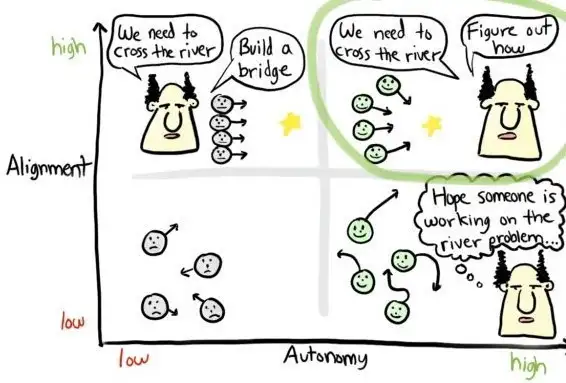Autonomy, Alignment, Purpose, and Urgency
I’ve talked about Autonomy, Alignment, Purpose, and Urgency before. What I haven’t done much of is compare and relate them. Particularly the Autonomy/Alignment and Purpose/Urgency pairs.
Autonomy is great. You get to decide what you (and/or your team) do. You decide what you think is important and you go do it. You expect the work to be impactful, and you get to have fun doing it. Ask for forgiveness instead of permission.
Alignment gets everyone moving in the same general direction. It’s vector math. To make forward progress the sum of the vectors needs to be positive (for whatever positive means for you). To use a buzzword, it’s synergy between teams/groups. Everyone moves forward more than any individual would/could.
Purpose is the ever important why. Not the business purpose, although that’s important, but the internal desire to do something that will have a big impact in an area that’s personally important. As Daniel Pink said in Drive, “All of us want to be part of something bigger than ourselves, something that matters.”
Urgency is about timeliness. When does something need to be done? When a building is on fire the urgent things are to make sure people are safe, make sure the fire doesn’t spread, and put the fire out, in that order. Only after all that is done should you work on preventing the next fire.
The question is, how do they interact?
How much autonomy should you have? How much alignment? When there is neither autonomy nor alignment you end up with Brownian motion. People wander in random directions and overall, not much changes. A lot of alignment and not much autonomy gives you robots. People blindly doing what they’re told. Hopefully it’s the right thing. If not, oh well. Do it anyway since those are the orders. Too much autonomy and no alignment ends up with everyone moving fast, but in random directions, so again, there’s very little overall progress. When there’s a good balance of alignment and autonomy that you get the most progress towards the goal.
Then there’s urgency and purpose. They pair a little differently. Urgency is short term. Too much urgency, or urgency for too long leads to burnout. In gaming, everything was urgent Crunch Time regularly led to people leaving as soon as something shipped. Purpose is long term. It’s sustainable. The more purpose you have the more energy you have to apply. And when you achieve your purpose, you don’t feel exhausted, you feel whole.
Urgency is extrinsic. A sense of urgency is imposed from the outside. It often exhibits as micromanagement, or some seemingly arbitrary timeline. It happens through power differentials. The manager/boss wants something done and makes the team work harder. The team doesn’t have a choice. Work harder or suffer the consequences. Purpose, on the other hand, is intrinsic. It’s personal. It’s empowering. It’s shareable. Others can see and understand your purpose and join you in it.
Where it gets really interesting is how Purpose and Urgency interact with Alignment and Autonomy.
Purpose can drive alignment. If everyone has the same purpose, then they’re much more likely to align on the same goal. Urgency, with its external definition of the goal has the same result. The difference comes from the time horizon. If you’re only caring about the next few hours, you’ll probably get better results from an externally defined goal. If you’re thinking about the long-term results for your customer/user, then shared purpose is going to serve you better.
Purpose also drives you towards autonomy. While everyone might have the same general purpose, it’s unlikely that everyone’s exact purpose is the same. This leads people to group themselves by similarity of purpose, and then want to do what they see as the most important thing. They want autonomy to make those decisions. Urgency, with its externally defined goal and micromanagement, will reduce autonomy.
High urgency, while it can be effective in the short term, has the overall effect of pushing us to the top left quadrant of the graph. Which might be ok in the short term, if you really know what the goal is and no-one else does. But for long term success, it’s much better to have shared purpose and allow matching autonomy that pushed you to the top right quadrant. Which is where you have the best overall outcome.

